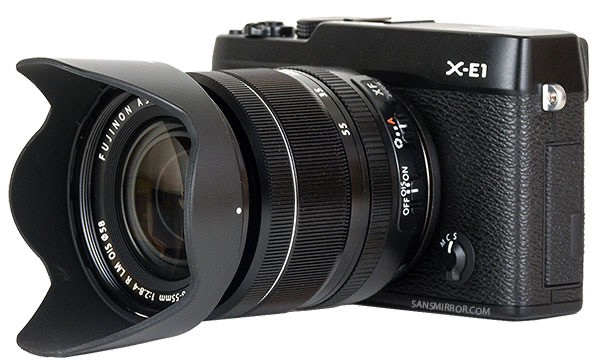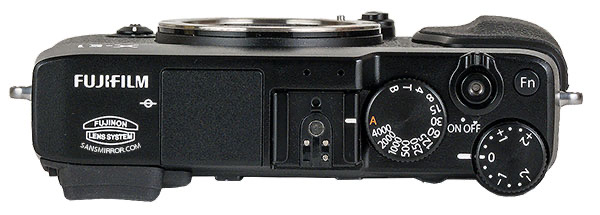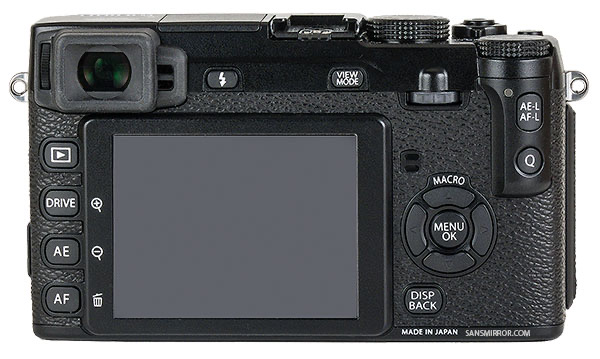Fujifilm X-E1 Review

Fujifilm XE-1 with 18-55mm f/2.8-4 zoom
What is it?
The X-E1 is a follow-on product similar to the X-Pro1 that uses the same sensor, electronic, and mount, but removes a few of the high-end X-Pro1 features. If you haven't already read my X-Pro1 review, please do so now, as I'll be trying to keep this review a bit more concise by not repeating things I wrote there. In terms of functional differences between the two cameras, here's the list:
Major Differences between X-Pro1 and X-E1
- X-Pro1 has hybrid optical/EVF finder; X-E1 has only EVF finder
- X-Pro1 EVF is lower resolution than X-E1 EVF
- X-Pro1 doesn't have diopter adjustment on finder; X-E1 does
- X-Pro1 supports mechanical cable release; X-E1 adds electronic release release support
- X-Pro1 has no internal flash; X-E1 has small pop-up flash
- X-Pro1's hot shoe centered on lens mount; X-E1 hot shoe offset slightly
- X-Pro1 connectors on right side of camera (from back); X-E1 connectors on left side
- X-Pro1 has PC-Sync connector (left side) from back; X-E1 does not
- X-Pro1 body is slightly larger (taller, wider, thicker) than X-E1 (some controls smaller, too)
- X-Pro1 shutter speed dial is lockable; X-E1 is not

XE-1 on left, X-Pro1 at right (size difference accurate)
In practice, I think the whole X-Pro1 versus X-E1 feature comparison boils down to two simple things: whether you want a hybrid viewfinder versus a higher specified EVF, and whether you prefer a smaller or larger body size. Other than those two things, we're splitting hairs in terms of differences in these cameras.
Another difference: price. The X-E1 is US$400 less expensive than the X-Pro1 at the moment. The big difference you're paying for is the hybrid viewfinder, so make sure that you know whether you want that or not.
Overall, the X-E1 presents itself as simple, clean, slightly retro style camera. Buttons are well marked and actually larger in size than most mirrorless cameras. The X-E1 does have its name writ large in white on the front, while the X-Pro1 is more low-profile and has no identity markings on the front.
Inside the X-E1 is Fujifilm's 16mp X-Trans sensor, same as in the X-Pro1. Indeed, virtually all the internal components are the same between the two cameras, and they certainly perform the same. An X-Pro1 user could quickly pick up an X-E1 and begin using it.

X-E1 still on left, X-Pro1 on right (size difference accurate)
How's it Handle?
Read my X-Pro1 review. Pretty much everything I write there applies directly here with two exceptions.First, the X-E1 body is a little smaller, and a few of the controls have slightly different positions or smaller sizes. Personally, I happen to like this, though the smaller shutter speed dial is a little more difficult to use with gloves. Likewise, the rear dial is a little more difficult to find with light gloves on. Other than that, though, the only real difference is a slightly more cramped right hand position that might impact people with big hands. I don't find it to be an issue, though, and prefer the slightly more svelte X-E1 over the E-Pro1.
The EVF is a win/lose proposition. The two wins on the X-E1 are the higher resolution (about two-thirds more pixels) and a much-needed diopter adjustment. The loss is a viewfinder that tends to jitter a bit more on panning, zooming, and motion. Neither the X-Pro1 nor the X-E1 EVF is the smoothest I've seen, but the X-E1 suffers a bit more from the low refresh rate with all those extra pixels. With the 14mm and 10-22mm lenses coming, trying to frame wide angle with the optical side of X-Pro1's viewfinder will become tougher, and the extra pixels of the X-E1 EVF will be welcome.
As with the X-Pro1 the X-E1 is a very retro-style camera when it comes to handling. You're back to using aperture rings, plus shutter speed and exposure compensation dials for the main controls.

The X-E1 has a small pop-up flash. You pop it up via a button on the back of the camera. Unfortunately, it won't clear the 18-55mm zoom very easily (especially with the lens hood on), and it even has a bit of a problem with the other lenses as well: lens shadows at the bottom of the frame are more the norm than the exception. So I don't find the pop-up very useful for direct flash. You can "fold it back" with your finger so it's in a more of a bounce position, but then you're fighting the low power of the flash. I'd have to say the inclusion of the flash is more a marketing check box feature than a well designed engineering feat. I could have done without it.

How's it Perform?
Exactly like an X-Pro1. Same image processing, same focus performance (now improved on the X-Pro1 with a firmware update at the X-E1's launch), same JPEG look, you name it.About the only performance piece that changes is battery performance. With the X-Pro1 I'm able to squeeze out some additional shots by avoiding using the EVF. With the X-E1, the EVF or LCD are always powered when you're shooting, so there's a constant draw on the battery you can't avoid. Curiously, Fujifilm doesn't put the CIPA specs in their brochures for the two cameras, probably because 350 shots doesn't look all that great for high-end cameras like these. An X-E1 user really needs to carry extra batteries handy if they want to do a full day of serious shooting. I'm averaging just over 300 shots a charge on my X-E1 in early testing, about the same as I was getting with the X-Pro1 using the EVF.
I should point out that the X-Trans sensor issues are still pretty much the same as they were when I did the X-Pro1 review. First, the X-E1 uses the same exact sensor, so the sparse color matrix is also exactly the same, and so are the raw conversion options. As I write this, I would still say that we don't have a truly optimized raw converter available, and some products, such as Apple Aperture (and any other product that relies upon the Macintosh OS X raw camera support), don't support the X-Trans at all. That means that color smearing and unwanted artifacts are still present in some X-E1 shots. I discuss this fully in the X-Pro1 review, but nothing has really changed since then.
Here's the out-of-camera JPEG for my usual basketball test:

Here's the raw file about as good as I can get it out of the Adobe converters:

I'm not displeased with the XE-1's (and X-Pro1's) performance in this tough gym. But it's not perfect, either. The X-Trans handles the low, mixed light pretty well, but has a slight tendency towards underexposure, probably due to the bright walls through the facility. Colors block up faster than I would have liked, and this, too, has to be an X-Trans issue, as it has less color detection than a Bayer pattern sensor of the same pixel count. But they don't block up badly, and texture and detail are still there in spades. A better raw converter might allow us to get even better results, and I look forward to one appearing.
Final Words
I liked the X-Pro1. I like the X-E1 just a tiny bit more, mostly because of the slightly smaller size and diopter on the EVF. In shooting with the X-Pro1 I found that, over time, I relied upon the optical side of the hybrid viewfinder less and less. Lenses poke into the frame in the optical view, and getting precise framing with the optical view is not possible. Given my personal preference for getting framing dead on in camera, if possible, I flipped the switch to the EVF an awful lot on my X-Pro1.With the X-E1 I'm not really missing the optical viewfinder; I don't find myself trying to flip out of the EVF view. Given that we now have a very capable zoom lens in the XF mount (the 18-55mm f/2.8-4), the reliance on an EVF goes up a little more. I do wish the EVF had a higher refresh rate, but I can live with what Fujifilm gave us, especially at the price point.
Since I try not to keep cameras around that I'm not using, I can also speak to the ultimate decider: I've decided to sell my X-Pro1. I don't need two XF bodies, and I value the compactness of the X-E1 more than the hybrid viewfinder of the X-Pro1, so it's an easy decision.
Aside: I'd guess that Fujifilm will update the X-Pro1 in 2013. In so doing, I also suspect that they would try to add a few features to differentiate that model from the X-E1. There aren't a lot of obvious such features, but a positionable LCD might be one.
Both are good cameras, and you need to make sure that none of the small list of differences tilts you one way or the other, but in terms of performance, they're essentially equal. The great JPEG quality Fujifilm is known for is present equally in both cameras. The handling is the same, though slightly miniaturized in a couple of places on the X-E1. The raw files are the same. The build quality is in the same league with both. In short, near identical twins, with only a couple of small feature differences differentiating them.
The lower price helps tilt things the X-E1's way, too. At the US$1000 body price, it's going up against the NEX-6 and NEX-7, the Olympus OM-D E-M5, and not much else. And it holds its own on the image quality side. Indeed, the X-E1 would be the best low light camera of that group. It would also be the slowest focusing camera of that group. The X-E1 has the most straightforward and understandable controls and menus of that group. The OM-D E-M5 has a wider range of lenses and accessories, but the existing Fujifilm lenses are all quite good—there's not a truly weak performer in the bunch (at least so far). Note that the X-Pro1, at US$400 more, has only the hybrid viewfinder to further stand out against those competitors.
So kudos to Fujifilm. They took a fine camera, did some careful liposuction and one feature cut, and didn't harm the patient at all. If anything, they created a slightly more compelling product due to the lower price point.
One last point: if you're into Leica lenses, the X-E1 is like the X-Pro1: with the Fujifilm M-mount adapter and the built-in lens corrections, these X-Trans cameras are the best crop sensor Leica M-mount option out there.
Recommended
Features — Other than sensor stabilization, nothing to complain about.
Performance — the most controversial of my ratings, I'm sure. Thing is, for image quality it's probably a four star product despite the color smearing issue. But all the battery and focus performance factors would be a two compared to the competition (in other words, lower than average). A lot of you will see this differently than I. Image quality hounds would likely give this camera four stars. I, however, believe that performance is the sum of the parts, thus my rating.
Value — Another area where I'm going to get disagreement. The lower price with basically only the removal of the hybrid viewfinder as a significant change pushes this camera slightly towards being a good value. That's especially true if you are a low light shooter, shoot with M-mount lenses, or can get by with the very good 18-55mm f/2.8-4 zoom.

No comments:
Post a Comment